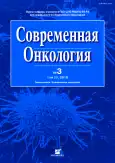Catamnesis of pediatric thoracic and abdominal cancer survivours
- Authors: Mikhailova SN1, Zaeva GE1, Gavrilenko TF1, Sinyagina Y.V1, Kazantsev AP1
-
Affiliations:
- N.N.Blokhin National Medical Research Center of Oncology of the Ministry of Health of the Russian Federation
- Issue: Vol 20, No 3 (2018)
- Pages: 35-42
- Section: Articles
- URL: https://journals.rcsi.science/1815-1434/article/view/29566
- DOI: https://doi.org/10.26442/1815-1434_2018.3.35-42
- ID: 29566
Cite item
Full Text
Abstract
Full Text
##article.viewOnOriginalSite##About the authors
S N Mikhailova
N.N.Blokhin National Medical Research Center of Oncology of the Ministry of Health of the Russian Federation
Email: astra-sn@mail.ru
канд. мед. наук, зав. научно-консультативным отд-нием НИИ детской онкологии и гематологии 115478, Russian Federation, Moscow, Kashirskoe sh., d. 23
G E Zaeva
N.N.Blokhin National Medical Research Center of Oncology of the Ministry of Health of the Russian Federationканд. мед. наук, вед. науч. сотр. научно-консультативного отд-ния НИИ детской онкологии и гематологии 115478, Russian Federation, Moscow, Kashirskoe sh., d. 23
T F Gavrilenko
N.N.Blokhin National Medical Research Center of Oncology of the Ministry of Health of the Russian Federationврач приемного отд-ния НИИ детской онкологии и гематологии 115478, Russian Federation, Moscow, Kashirskoe sh., d. 23
Yu V Sinyagina
N.N.Blokhin National Medical Research Center of Oncology of the Ministry of Health of the Russian Federationканд. мед. наук, врач научно-консультативного отд-ния НИИ детской онкологии и гематологии 115478, Russian Federation, Moscow, Kashirskoe sh., d. 23
A P Kazantsev
N.N.Blokhin National Medical Research Center of Oncology of the Ministry of Health of the Russian Federationд-р мед. наук, зав. отд-нием опухолей торакоабдоминальной локализации НИИ детской онкологии и гематологии 115478, Russian Federation, Moscow, Kashirskoe sh., d. 23
References
- Детская онкология. Национальное руководство. Под ред. М.Д.Алиева, В.Г.Полякова, Г.Л.Менткевича, С.А.Маяковой. М.: Издательская группа РОНЦ, 2012.
- Заева Г.Е., Валиев Т.Т., Гавриленко Т.Ф и др. Отдаленные последствия терапии злокачественных опухолей у детей: 35-летний опыт клинических наблюдений. Современная Онкология. 2015; 18 (1): 55-60.
- Berbegall A.P, Bogen D, Pötschger U et al. Heterogeneous MYCN amplification in neuroblastoma: a SIOP Europe Neuroblastoma Study. Br J Cancer 2018. doi: 10.1038/s41416-018-0098-6
- Trobaugh-Lotrario A.D, Chaiyachati B.H, Meyers R.L et al. Outcomes for patients with congenital hepatoblastoma. Pediatr Blood Cancer 2013; 60 (11): 1817-25. doi: 10.1002/pbc.24655
- Koshinaga T, Takimoto T, Oue T et al. Outcome of renal tumors registered in Japan Wilms Tumor Study-2 (JWiTS-2): A report from the Japan Children's Cancer Group (JCCG). Pediatr Blood Cancer 2018; 65 (7): e27056. doi: 10.1002/pbc.27056. Epub 2018 Apr 6
- Рябов. А.Б. Современная стратегия детской торако-абдоминальной онкохирургии. Автореф. дисс. … д-ра мед. наук. М., 2012.
- Заева Г.Е., Синягина Ю.В., Моисеенко Е.И., Сухановская Е.Н. Катамнез пациентов, в детстве излеченных от онкологических заболеваний. Материалы XVII Российского онкологического конгресса. Москва, 12-14 ноября 2013.
- Вололин Н.Н., Касаткин В.Н., Цейтлин Г.Я. и др. Стратегия медико-психолого-социальной реабилитации детей с гематологическими и онкологическими заболеваниями. Онкогематология. 2015; 1.
- Ishida Y, Maeda M, Adachi S et al. Secondary cancer after a childhood cancer diagnosis: viewpoints considering primary cancer. Int J Clin Oncol 2018. doi: 10.1007/s10147-018-1303-6
Supplementary files







